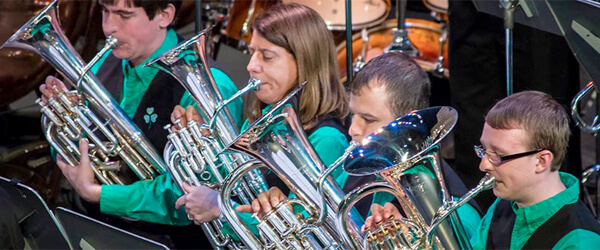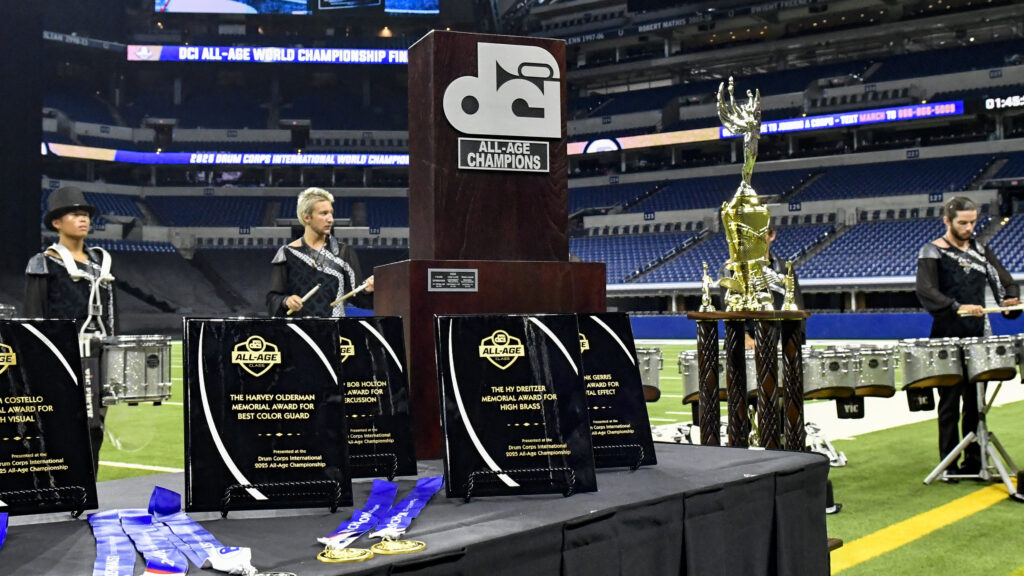Top brass ensembles gathered in the suburbs of Chicago Saturday, Nov. 2 for the annual U.S. Open Brass Band Championships, a competitive showcase featuring groups from across the country. As DCI.org columnist Michael Boo found out attending last weekend’s event, what on the surface may look like a typical concert setting, is one that shares plenty of connections to the drum corps activity from musical programming and presentation to personnel.

This is an activity that drum corps fans would instantly love. At times it can pin your ears back with its super loud volume, and at other times it is quiet and introspective. Brass bands are seeing an increasing use of on and off-stage movement, though most of the repertoire is performed seated. In the distant past, most shows consisted of a variety of selections that had no connection with one another; but today, as with drum corps, most shows have a theme. The U.S. Open Brass Band Championships encourages the bands to be entertaining and even provides a judged caption for entertainment. Dallas Niermeyer, director of the Prairie Brass Band and head DCI Brass Judge in the mid-1970s, founded the Championship in 2003. Since its beginning, longtime DCI timing and penalties judge Joe Courtney has provided the same service to the event and longtime DCI tabulator Tom Kosin—assisted by his wife Peggy—has tabulated the judges’ sheets. The instrumentation, though different from drum corps and even different from concert bands, allows for a variety of different sounds. Much of the music originally written for brass bands has made it onto the drum corps field, most recently in the three Bertrand Moren and Paul-Lovatt Cooper works that appeared in Carolina Crown’s 2013 production. Just a handful of other memorable examples of brass band music on the football field include selections from the Cavaliers’ 2009 “The Great Divide,” the Cadets’ entire 1997 “Celebration” show by Philip Sparke and Blue Knights’ “Trittico.”
The on-stage X's and O's

Here is a very brief primer on brass band instrumentation, courtesy of Josh Jameson, arranger for the Dublin Silver Band from Ohio, a baritone player for the Glassmen from 2007-2009 and the corps’ drum major in 2010 and 2011. An abundance of cornets (not trumpets) play a number of parts. Four solo cornets in B-flat essentially play all the technical material, such as difficult licks that in an orchestra would be performed by the strings. Though essentially playing the same part, they can be split up. One soprano cornet in E-flat plays high note passages that are often independent from the rest of the music, adding the frills that a piccolo might add in an orchestra or band. A single B-flat repiano cornet floats around wherever needed to support other parts, though it can also be independent. Two 2nd and two 3rd cornets provide powerful impact points, like the trumpet parts do in an orchestra. A single flugelhorn in B-flat is often a solo instrument, but can provide a bottom to the cornet choir or may team up with the tenor horns. The three E-flat tenor horns—often referred to as alto horns in the United States—look unlike anything else in the concert band; smaller than French Horns, with bells pointing up. Divided into three parts, they operate in the same manner as mellophones on the drum corps field, providing the mid-voice impact. Two B-flat baritones are quite flexible, sometimes doubling the tenor horns and sometimes the trombones, and often, in two parts, filling in the gaps between each of those other sections. Two euphoniums in B-flat are often utilized in a virtuoso solo capacity. They are frequently used in two parts as the bottom of the horn choir or the top of the tuba choir.
Highlights from the 2012 U.S. Open Brass Band Championship
Two B-flat trombones, more piercing than the other instruments due to their mellower cylindrical bores, provide brassiness in the lower register. Each plays a separate part, accompanied by a third member of the section playing bass trombone, which adds oomph to the bass section. Curiously, the bass trombone, which came later to the world of brass bands, is the only low brass instrument that plays in the bass clef. The baritones, euphoniums, and even the tubas all play treble clef. (While all drum corps brass parts were originally written in treble clef, these days, the increased number of band members and the ease of which computerized parts can be printed in either clef has made lower brass bass clef parts much more common.) There are two E-flat tubas, mostly playing in unison, and two B-flat tubas, also mostly playing in unison. They usually play different pitches, though they can play the same parts, depending on the scoring. The instruments will look essentially the same to the untrained eye, but the E-flat tubas are a tad smaller. The combination of the two keys adds a richness and sonority that is fuller in character than tuba parts in a concert band. Three or four percussionists play a wide variety of instruments, including symphonic drums, drum set, mallet keyboards, cymbals and gongs, timpani and various accessories you would find in a drum corps front ensemble.
Brothers and sisters in brass

Josh Jameson plays bass trombone for the Dublin Silver Band. He believes that fans of drum corps would appreciate brass bands and admits not enough corps fans know the activity exists. This is despite brass bands increasingly pulling many of their programming ideas from DCI shows and each activity having evolved in much the same manner. Jameson sees similarities in the brass band performances to the Tony Award-winning stage show “Blast!” which has its roots in the drum corps activity. He says both brass bands and drum corps strive for excellence and entertainment, and all the brass players are members for the purpose of accentuating their love of brass playing. “Drum corps people would get hooked and really need to see this,” Jameson said. “We too have the ability to tell a story, to make people feel something in addition to enjoying the music. It’s not just about playing the notes.” Ed Tappan plays cornet with the Capital City Brass Band of Lansing, Michigan. He played soprano bugle for Northern Aurora in 1995 and mellophone for the Madison Scouts in 1996. “I believe brass band is a perfect transition from drum corps, filling a void brass players can’t get in concert band,” says Tappan. “The technical challenges are unmatched … It is the closest thing to drum corps in a concert hall setting. It’s the closest I’ve come to feeling drum corps energy in an ensemble.” Bill Waterman, music director of Capital City Brass Band of Jackson, Mich., played tuba with the Crossmen in 2001 and 2002. “Brass bands can deliver the most impressive, artistic imitation of woodwind and string sounds one moment, then can blow you away with the power of the brassiest sound you’ll ever hear outside of drum corps,” he said. Paul Bessetti plays cornet for the Fountain City Brass Band of Kansas City. He marched as a member of Lake Erie Regiment from 1997-1999 and has been a staff member of the Crossmen and currently the Colts. He’s delighted how drum corps have discovered music originally written for brass bands, which has helped familiarize corps fans with much of the repertoire. Bessetti points out the differences between brass bands and drum corps: “Drum corps is straight-ahead and aggressive, while brass bands derive from the English style. Vibrato is used in brass band constantly, but rarely in drum corps. The music in drum corps is more fragmented, built around effect, while a lot of brass band music can be considered to be based on a more vocal approach.” However, he also finds many similarities between the two idioms: “Brass bands, like drum corps, is entertaining, demanding and musical. It’s as close as most can get to being in a drum corps in the professional world. I get to play with 30 other brass players, and there isn’t much opportunity to do that once you age out.” Randil Jeffreys plays euphonium in the Eastern Iowa Brass Band and is a four-year veteran of the Cavaliers. “If you love in-your-face brass music, this is a more intimate setting of the same medium,” Jeffreys said. “Brass band events are an extension of what you get on the field, with a lot more of the brass technique, lots of diverse musical selections, and lots of fantastic players who don’t have to worry about running around on the field while playing the music.” The Eastern Iowa Brass Band has five members who marched in drum corps, representing the Colts, Blue Devils, Madison Scouts, Cavaliers and Knights. David Huntley was a member of the Colts from 1979 to 1981 and the Cavaliers in 1982. He says that the biggest joy of being a percussionist in a brass band is the ability to “continue to play my music and be exposed to music I’ve loved hearing.”
Bone Up On Brass Bands
While the next U.S. Open Brass Band Championship won’t take place until Nov. 8, 2014, there are plenty of ways to learn more about and get involved with brass bands across the country and around the world. • Read an in-depth review of the performing ensembles at the 2013 U.S. Open written by DCI.org columnist Michael Boo. • Learn more about the U.S. Open Brass Band Championship online (usopenbrass.org) and on Facebook. • A variety of CDs are available to purchase online from past U.S. Open Brass Band Championships. • BBC Radio 2 in England hosts a weekly program called “Listen to the Band” which is a showcase of brass and military band music. Photos courtesy Dan Landbo, U.S. Open Brass Band Championships.

Michael Boo was a member of the Cavaliers from 1975-1977. He has written about the drum corps activity for more than a quarter century and serves as a staff writer for various Drum Corps International projects. Boo has written for numerous other publications and has published an honors-winning book on the history of figure skating. As an accomplished composer, Boo holds a bachelor's degree in music education and a master's degree in music theory and composition. He resides in Chesterton, Ind.





